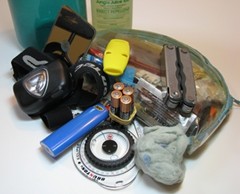
 Protect spare batteries from moisture and corrosion by putting them in a plastic bag or covering them in plastic wrap. Store them in your first aid kit so they'll remain safe and accessible.
Protect spare batteries from moisture and corrosion by putting them in a plastic bag or covering them in plastic wrap. Store them in your first aid kit so they'll remain safe and accessible.
 To pack duct tape without bringing a heavy roll, wrap several feet of tape around a plastic water bottle. Rip off pieces of the tape as you need it to make repairs or bandages.
To pack duct tape without bringing a heavy roll, wrap several feet of tape around a plastic water bottle. Rip off pieces of the tape as you need it to make repairs or bandages.
 If you fall into a fastflowing river, float on your back and point your legs downstream with your toes up. Use your legs to rebound off rocks, and don’t try to swim or stand up until you reach calmer water.
If you fall into a fastflowing river, float on your back and point your legs downstream with your toes up. Use your legs to rebound off rocks, and don’t try to swim or stand up until you reach calmer water.
 Tighten your shoelaces before long stretches of downhill hiking to prevent your toes and toenails from repeatedly slamming into the front of your boots.
Tighten your shoelaces before long stretches of downhill hiking to prevent your toes and toenails from repeatedly slamming into the front of your boots.
 Packing your gear in multiple small stuff sacks instead of several large ones will speed up loading and allow you to squeeze gear into every corner of a pack. Better yet: don't use stuff sacks at all.
Packing your gear in multiple small stuff sacks instead of several large ones will speed up loading and allow you to squeeze gear into every corner of a pack. Better yet: don't use stuff sacks at all.
 The most equitable way to pack a two-person backpacking tent is to have one person carry the inner canopy and the other person take the rainfly, poles, and stakes.
The most equitable way to pack a two-person backpacking tent is to have one person carry the inner canopy and the other person take the rainfly, poles, and stakes.
 Before using a tent for the first time, apply a waterproof sealant to seams on both sides of the rainfly. Even though these seams were taped and sealed in the factory, it’s a good idea to re-waterproof them using a seam sealer (found at most outdoor stores) before your first outing.
Before using a tent for the first time, apply a waterproof sealant to seams on both sides of the rainfly. Even though these seams were taped and sealed in the factory, it’s a good idea to re-waterproof them using a seam sealer (found at most outdoor stores) before your first outing.
 You can estimate the remaining hours of daylight by counting the number of outstretched hands you can place between the bottom of the sun and the horizon. Each stack of four fingers represents one hour of daylight.
You can estimate the remaining hours of daylight by counting the number of outstretched hands you can place between the bottom of the sun and the horizon. Each stack of four fingers represents one hour of daylight.
 When scrambling up or down talus and scree slopes, avoid climbing directly above another person—any rocks you dislodge could strike those below. Climb diagonally, or stay close together.
When scrambling up or down talus and scree slopes, avoid climbing directly above another person—any rocks you dislodge could strike those below. Climb diagonally, or stay close together.
 To calculate how far away a thunderstorm is from your location, divide the number of seconds between the lightning and thunder by 5 to determine the distance in miles. For example, a delay of 10 seconds means the storm is 2 miles away—which is extremely close. Start looking for cover when a thunderstorm is 6 miles (a gap of 30 seconds) away.
To calculate how far away a thunderstorm is from your location, divide the number of seconds between the lightning and thunder by 5 to determine the distance in miles. For example, a delay of 10 seconds means the storm is 2 miles away—which is extremely close. Start looking for cover when a thunderstorm is 6 miles (a gap of 30 seconds) away.
 When hiking downhill, increase the length of your trekking poles several inches to give your arms additional reach. Likewise, shorten the poles when going uphill.
When hiking downhill, increase the length of your trekking poles several inches to give your arms additional reach. Likewise, shorten the poles when going uphill.
 The color of your urine is a reliable indicator of your hydration state. Clear urine indicates adequate hydration, while dark yellow urine means you aren’t drinking enough.
The color of your urine is a reliable indicator of your hydration state. Clear urine indicates adequate hydration, while dark yellow urine means you aren’t drinking enough.